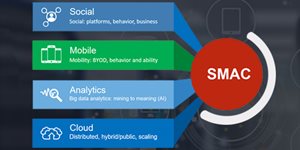The ECM Market: What Happened in 2017 & What's Next in 2018
By Venus Tamturk
November 22, 2017
acquisition, Alfresco, Artificial Intelligence, Cloud, collaboration, content services, Enterprise, Enterprise Content Management, Forrester, gartner, Hyland, Laserfiche, machine learning, Nuxeo, OpenText
As 2017 comes to a close and the enterprise looks toward 2018, it is that time of year again when I dive into the predictions and trends for the enterprise content management industry for the next year just after briefly reviewing what events and trends shaped this year.
The 2017 ECM Market in Review
Before diving into what’s next in 2018, let’s have a glance at what happened to the market in  2017. According to the data by Gartner, the market saw an 8% growth from 2015 to 2016, with global revenue up to $6.1 billion from $5.6 billion. Good news, this healthy expansion of the market persisted this year as well.
2017. According to the data by Gartner, the market saw an 8% growth from 2015 to 2016, with global revenue up to $6.1 billion from $5.6 billion. Good news, this healthy expansion of the market persisted this year as well.
Like every year, mergers and acquisitions made waves in the space this year too. Arguably, the biggest M&A news in the market was OpenText completing on the previously announced acquisition of Dell EMC’s Enterprise Content Division, including Documentum. Another big piece of M&A news in the space was that Westlake, Ohio-based Hyland announced the completion of its acquisition of the Perceptive business unit which is a part of the enterprise content management business unit of Lexmark International that Hyland acquired in 2016. With the acquisition of Perceptive, the vendor is expected to expand its global footprint as currently, its global sales and support options, outside of North America, may be inconsistent, depending on the location.
Besides the M&A news, this year wasn’t short of innovation as almost all major ECM vendors rolled out a set of new tools for their content management platforms to help their customers tackle a wide range of enterprise issues from productivity to time-to-market. OpenText, for instance, built its new AI platform by leveraging text mining and semantic analysis to help enterprises orchestrate unstructured and semi-structured information, in areas such as enterprise content management, customer experience, and data discovery. There are so many immediate use cases of the platform in verticals from human resources tasks like employee self-service, recruitment, and retention of fleet management, such as marketing personalization, inventory utilization, and vehicle maintenance. Box, on the other hand, announced a deepening relationship with Microsoft to co-sell its cloud content management platform with Azure to enterprise customers, and add Microsoft's machine learning and artificial intelligence services into its platform. M-Files waded into the foray as it added more AI functionality to its platform through a partnership with ABBYY, an artificial intelligence (AI), text-scanning and optical character recognition software company.
These examples above represent only a fraction of the AI-based innovation news that occurred in the space throughout this year. Regardless of the vendor name, the main takeaway here is to understand what has led ECM vendors to rethink how enterprise content is managed. The primary drivers behind these innovative solutions were:
-
As the pace of business and the need for collaboration persist to accelerate, enterprises were struggling with managing and protecting their sensitive content as well as enabling their multi-cultural teams to collaborate on the same project in real time.
-
Enterprises need solutions that categorize large volumes of content exponentially faster than humans.
Among other reasons, the demand for unlocking the full potential of the intelligent enterprise set a domino effect in motion of rising ECM vendors to adopt stronger, more tightly integrated artificial intelligence capabilities through either acquisition or from building the capabilities in-house.
It is expected for any market in technology to evolve more and more every year as digital transformation is happening at light speed. However, this year, the ECM market went beyond  evolving so much so that on one hand, Gartner’s analysts suggested to kill the term of ECM and replace it with Content Services, on the other hand, AIIM, which is a non-profit industry association with more than 80,000 community members, claimed that there have been five distinct technology waves or eras in dealing with the challenge of managing the people, process, and information intersection, and the ECM era was the last one of them as now, we are making a transition to this sixth era (still to be defined) dominated by Mobile, Analytics, Cloud, and Collaborative (MACC) technologies.
evolving so much so that on one hand, Gartner’s analysts suggested to kill the term of ECM and replace it with Content Services, on the other hand, AIIM, which is a non-profit industry association with more than 80,000 community members, claimed that there have been five distinct technology waves or eras in dealing with the challenge of managing the people, process, and information intersection, and the ECM era was the last one of them as now, we are making a transition to this sixth era (still to be defined) dominated by Mobile, Analytics, Cloud, and Collaborative (MACC) technologies.
Now, I do not know for sure whether ECM is not adequate enough as a term or if the capabilities of the ECM tools have outgrown their definition but, this definitely means that a new wind of enormous change is blowing! To not to be blown away by this wind, I thought some industry veterans’ predictions for 2018 may help us navigate these daunting waters and even ride the upcoming waves to take our businesses to the next level. To that point, I consolidated some predictions from leadership of some ECM behemoths:
The ECM Veterans Answered: What Will Drive the ECM Market in 2018?
Cognitive Analytics & Cloud-Based Content Services
“90 percent of the information within an organization has been unstructured or semi- structured content, including contracts, powerpoint presentations, word documents, and conversational discussions in the audio format. They all constitute the mass majority of information within the Enterprise,” said OpenText CMO Adam Howatson, who has been with OpenText in various positions for over 15 years. He believes that businesses need a cognitive analytics platform that is capable of conducting unstructured content analysis across more than tens of thousands of documents and giving insights on, for instance, what language their customers are using, when they interact with businesses, what specifically they are asking for, what types of problems they are solving, what sort of solutions they are using, and how businesses have responded to them so far. When it comes to the reason why these types of insights would be important for him as a business owner or a decision maker, he said: “I want to correlate all of that data and surface the major trends because that will help inform me in the way that I take our products to market and I do our positioning and messaging.” Therefore he believes “cognitive solutions and unstructured content analytics will be one of the major trends in the coming years.”
structured content, including contracts, powerpoint presentations, word documents, and conversational discussions in the audio format. They all constitute the mass majority of information within the Enterprise,” said OpenText CMO Adam Howatson, who has been with OpenText in various positions for over 15 years. He believes that businesses need a cognitive analytics platform that is capable of conducting unstructured content analysis across more than tens of thousands of documents and giving insights on, for instance, what language their customers are using, when they interact with businesses, what specifically they are asking for, what types of problems they are solving, what sort of solutions they are using, and how businesses have responded to them so far. When it comes to the reason why these types of insights would be important for him as a business owner or a decision maker, he said: “I want to correlate all of that data and surface the major trends because that will help inform me in the way that I take our products to market and I do our positioning and messaging.” Therefore he believes “cognitive solutions and unstructured content analytics will be one of the major trends in the coming years.”
Another trend besides cognitive and analytical capabilities for unstructured content Howatson states is that we will see the massive pivot to Cloud: “It’s very much a hybrid world still today. It’s not a binary decision for companies, not like everything goes to a cloud or everything is on premises as it is very much a hybrid approach today but I think, we are going to see continued and increasing options of cloud-based services whether those are NET services or SaaS type of applications, and I think that will be another major trend as well.”.
Accessible Content & Security
Bill Priemer, President and CEO at Hyland, stressed these two important areas of focus, any  device/anywhere access to content and security.
device/anywhere access to content and security.
“In this mobile, connected world, where everything is electronic and the speed of business is constantly accelerating, content services enable organizations to keep pace — to work toward the promise of true digital transformation. Many of our customers are taking digital transformation to the next level. Where the first wave saw businesses looking for ways to go paperless and automate transactional processes, customers are now using their ECM systems to develop purpose-built applications that replace niche solutions and reduce IT sprawl. With a content services platform like OnBase — which incorporates not just ECM, but BPM, case management, and secure file-sharing capabilities — organizations have a toolkit they can use to tackle a wide range of information and process management challenges.”
“Additionally, security is a paramount concern for our customers, and for us, and will continue to be a trend that requires constant innovation. We’re managing some of the most proprietary and sensitive information there is, from financial to personal health to intellectual property, so there’s no room for error. Accordingly, we are devoting the resources and investing in the tools so that our applications, our cloud infrastructure and our processes for handling customer information are all as secure as they can be.”
AI & Cloud-Native ECM & Consumer-Grade Content Services Applications
Chris McLaughlin, CMO at Nuxeo, sees a significant number of trends in ECM. Some of the  most important include:
most important include:
-
"The rapid shift from traditional, ECM suite offerings – often cobbled together through acquisition – to purpose-built Content Services Platforms that are designed to be true information (content) “hubs” for the enterprise."
-
"The increasing importance of the Cloud and Cloud-native ECM architectures that provide greatly improved scalability and performance at a much lower total cost of ownership (TCO)."
-
"The emergence of artificial intelligence (AI) and machine learning to better describe unstructured information (content) and to enable CSPs to be more predictive and accurate in the way that they deliver content to knowledge workers."
-
"And, the continued consumerization of the user experience. This is expressed both in terms of mobile-first design paradigms as well as the emergence of new, consumer-grade Content Services Applications that address critical business needs and use cases."
Cloud & Information Governance & AI/Machine Learning
Chris Wiborg, Vice President of Product Marketing at Alfresco consolidated his thoughts  around the top three trends below:
around the top three trends below:
-
Cloud: "As with most markets, cloud is still a significant disruptor. Every customer I talk to is figuring out what this means to them when it comes to content. Most are developing policies where they segment the types of content they have… and what belongs where. It is not a 'one size fits all' deployment model world as some would ask you to believe, that’s for sure."
-
Information governance: "New regulations are popping up all the time that bring a different focus to the table: global ones such as GDPR, as well as ones that are very specific such as 23 NYCRR 500. So, I’d predict a renewed focus on information governance in the days ahead, even if that’s not a particularly new topic."
-
AI/machine learning: "The one where the most innovation is going to occur is around making content 'smarter' than ever before. If ~80% of an organization’s content is in an unstructured format, how can we unlock that value in the context of Digital Transformation? This has been a bit of a holy grail for some time now – but with the recent advances in big data analytics and AI/machine learning technologies, it’s 'game on' for most customers in figuring out how they can gain a competitive advantage here. Given our open-source roots, this is where our CTO and founder is spending much of his time these days: on looking at how an open source approach to AI can help us all accelerate beyond the proprietary offerings of today."
Contextual Content
Catherine Wilson, Laserfiche Director of Operations, oversees partnership marketing and  strategy, and leads analyst relations at Laserfiche, and over the next few months, she expects the continued demand for contextual information coupled with evolving approaches to interacting with content will drive innovation in the ECM space: “We are already seeing organizations rethink the way they create and collaborate to transform their daily operations. Simple adjustments—such as adding mobile task notifications—add a new dimension of real-time data that positions them for faster and more accurate content services. Similarly, more and more organizations are embedding content services into other line of business applications using integration tools such as Laserfiche Connector.”
strategy, and leads analyst relations at Laserfiche, and over the next few months, she expects the continued demand for contextual information coupled with evolving approaches to interacting with content will drive innovation in the ECM space: “We are already seeing organizations rethink the way they create and collaborate to transform their daily operations. Simple adjustments—such as adding mobile task notifications—add a new dimension of real-time data that positions them for faster and more accurate content services. Similarly, more and more organizations are embedding content services into other line of business applications using integration tools such as Laserfiche Connector.”
Cloud & Cognitive Analytics
Stephen Ludlow, Senior Director, Enterprise Product Marketing, was exactly on the same page  with his colleague Adam Howatson as he also emphasized the emerging importance of cloud as well as cognitive analytics solutions for unstructured content.
with his colleague Adam Howatson as he also emphasized the emerging importance of cloud as well as cognitive analytics solutions for unstructured content.
“We will obviously see continued interest and confidence in shifting ECM and Content Services to the cloud. In the short term, we see customers looking to extend their existing investments with cloud-based content services where cloud is best suited. We see innovation coming in areas where sharing and collaboration is needed with partners and customers outside the firewall, via mobile apps, and built-for-purpose apps that deliver intuitive interfaces into the business process.”
“Cognitive solutions and unstructured content analytics will also be one of the major trends in the coming years. With such a massive amount of data being generated within every organization, it’s never been more vital to be able to correlate all of that data and surface the major trends and insights to inform market strategy, positioning, and messaging.”
Predictions by Gartner & Forrester
Gartner predicts:
-
20% of major enterprise file synchronization and sharing (EFSS) and ECM vendors will  transform their existing offerings into content service platforms.
transform their existing offerings into content service platforms.
-
15% of enterprises will have replaced their traditional ECM provider with a provider that offers consumerlike content services by 2020.
-
40% of new enterprise applications implemented by service providers will include AI technologies by 2021.
The Stamford, Conn.-based research firm foresees the content services platform (aka ECM) market to continue to be dynamic and innovative as well as show growth.
Forrester
-
Forrester expects Enterprise Content Management (ECM) to be a global market worth $8  billion in 2017 and predicts that the market will reach $9 billion in 2018.
billion in 2017 and predicts that the market will reach $9 billion in 2018.
-
A recent Forrester survey revealed that only 33% of surveyed ECM decision makers were actively using mobile devices to access or use their ECM systems. A further 39% had plans to adopt mobile into 2017-18. 28% had no firm plans to introduce mobile use for ECM. The takeaway from these Forrester figures is that the adoption of mobile is still quite low in the ECM market, meaning the opportunity lies therein for the ECM vendors as mobile-first design represents an area to improve upon.
-
According to Forrester’s market observation cited in the Forrester Wave: Enterprise Content Management — Business Content Services, Q2 2017, new ECM entrants are closing deals with cloud-native content platforms or modern architectures that support the delivery of flexible, granular, purposeful applications. The reason behind this trend is that longtime ECM vendors’ complex, highly customized on-premises deployment options lead enterprises to consider new cloud-native content platforms. The market research firm expects the demand for cloud-native content platforms to continue in 2018 as well.
-
A recent survey conducted by Forrester Consulting for ASG Technologies unveiled that while enterprise content management today is predominantly deployed on-premises, within the next two years, 90% of organizations will be using cloud-based content management systems, either as a primary or hybrid approach. On that note, Gartner also cited in The Magic Quadrant for Enterprise Content Management that by 2018, half of the enterprises will manage content on hybrid systems (cloud/on-premise) and half of the big-name ECM vendors to re-architect their software to be cloud-based.
My POV
In a nutshell, tools driving real-time customer interactions are poised for a remarkable bloom in 2018. If I have to go in depth, then, here’s my list:
Cognitive analytics
The point of gathering data is to be able to translate all the data into meaningful actions. However, due to the ongoing explosion in the volume of data collected, many organizations are living in irony where they gather too much data but know too little about what this data represents. Not only do enterprises have to sort out unstructured data; but also they need to deal with unstructured content. According to the Economist, while content is doubling every 90 days, 80 percent of content used by knowledge workers for core revenue generation activities is unstructured. This explosive growth of unstructured content is becoming a big challenge for many organizations, especially for enterprises.
To address these emerging issues, vendors have been launching cognitive analytics platform. The competition in this area even came to the point where the leaders of longtime ECM vendors started publicly feuding. OpenText CTO and CEO Mark Barrenechea, for instance, publicly took aim at IBM’s cognitive learning engine, Watson, pointing out its closed ecosystem, limited deployment options, and high cost while claiming their open source cognitive analytics platform Magellan is able to deal with 90 percent of the issues that businesses want to address through analytics by analyzing both structured and unstructured information.
Some analytics platforms powered by cognitive computing technologies have even started going beyond conventional text analysis to deep semantic analytics to provide an in-depth understanding of, say, emotions within languages and a customer’s response to them within a marketing scenario. In 2018, as many leaders also aforementioned above, we will see the rise of those platforms.
Cloud
Approximately 60% of the average employee’s day is spent working on an organization’s records and documents. According to Forbes Insight, 95% of organizations agree that strong information management is critical to business success. No wonder why the document and content management solutions are considered as the largest components of the enterprise content management market. The sheer volume of documents and content generated in an enterprise on a daily basis has driven the need to manage and store the generated data as well as to maintain metadata files. With on-premise solutions, content is managed but not necessarily maximized, but with a cloud-based ECM, content is delivered in line with process creating business value. Therefore, the adoption of a cloud-based ECM solution will keep making a wave that all ECM vendors need to ride through in 2018.
In fact, the cloud Enterprise Content Management (ECM) market size is expected to grow from USD 9.77 Billion in 2017 to USD 34.42 Billion by 2022, at a Compound Annual Growth Rate (CAGR) of 28.6%, reports MarketsandMarkets.
Usability
With the introduction of the iPhone in 2007 which marked the mobile revolution, users’ expectations of the web and digital experiences have entirely changed. Since then, usability has always been the functionality that no vendor would want to compromise on. It won’t change in 2018 either. In fact, a focus on usability will become even more important considering 75% of the workforce will be millennials by 2020, and this new generation is not known for their high tolerance of cumbersome and lacking features, as they are used to working with fast technology solutions.
The next versions of ECM solutions will need to be able to drive productivity and enable employees to collaborate and share content smoothly, with both personal and corporate technology devices in a secure manner. Therefore, the use of SaaS ECM solutions are rising, and more and more businesses have started shifting to it.
Collaborative Technologies
MarketsandMarkets revealed that Asia Pacific (APAC) is expected to grow at the fastest CAGR during the forecast period. The primary drive behind this pace of growth in the APAC region is the ever-increasing demand for managing the electronic data which arises from the rapid adoption of electronic devices. To me, the APAC being by far the fastest-growing market for ECM solutions makes sense - not only because of the region’s high adoption of the latest smartphone or phablet devices but also because of its inherent culture of collaboration which is a distinguishing attribute of this market thus the enterprises in that region, typically, focus more on the strong digital workplace capabilities.
This situation is no different in North America and Europe. Therefore, digital platforms have been underpinning the creation of new business models by integrating ecosystems of people, business, and technology. Letting the cross-functional department work all together to develop a marketing campaign or sales pitch has lately been on many software makers’ radar. The ECM vendors will leverage their platform to help organizations create a collaborative environment around integrated workflows, business processes, data streams, and applications. The solutions that can deliver unique tailored experiences for various roles, minimize the amount of manual data entry, offer new efficiencies through mobile devices and apps, integrate with first-or third-party solutions to enrich the digital ecosystem, deliver AI-driven recommendations and next-best actions, and provide social media interactivity will be winners in 2018.

Venus Tamturk
Venus is the Media Reporter for CMS-Connected, with one of her tasks to write thorough articles by creating the most up-to-date and engaging content using B2B digital marketing. She enjoys increasing brand equity and conversion through the strategic use of social media channels and integrated media marketing plans.